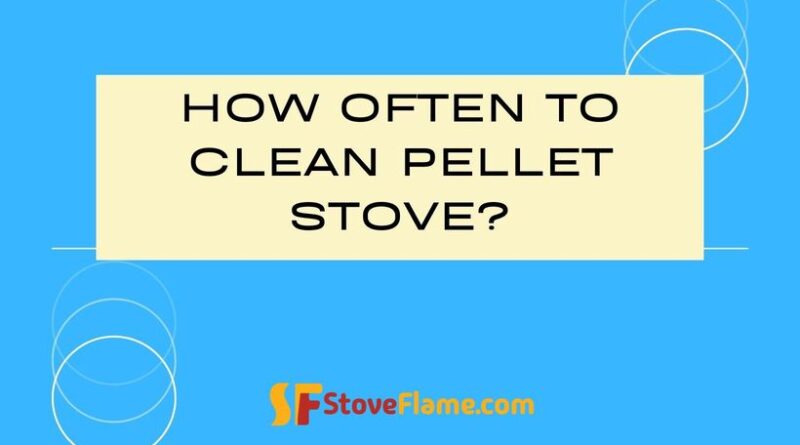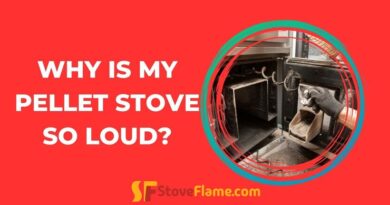How Often To Clean Pellet Stove?
Maintaining a pellet stove is essential for its efficient and safe operation. Regular cleaning not only prolongs the lifespan of the stove but also ensures that it is functioning at its best. Unlike traditional wood stoves, pellet stoves require less maintenance due to their advanced technology. However, this does not mean that they can be neglected.
Proper cleaning and maintenance are crucial to prevent potential hazards such as fires, carbon monoxide leaks, and air pollution. With that said, one of the common questions that arise among pellet stove owners is, “How often should I clean my pellet stove?”
In this guide, we will explore the significance of regular cleaning and offer a detailed overview of how frequently you should clean your pellet stove to maintain its peak performance. Whether you’re a new pellet stove owner or have been using one for a while, this article aims to equip you with the essential knowledge to help keep your pellet stove clean and operating at its best.
Understanding Pellet Stove Maintenance Requirements
Proper maintenance of a pellet stove is crucial for its efficient and safe operation. While the frequency of cleaning may vary depending on factors such as stove usage and pellet quality, it is essential to understand the general maintenance requirements to keep your pellet stove running smoothly.
Regular cleaning of the burn pot, ash pan, and exhaust system helps to prevent the build-up of ash and creosote, which can affect the stove’s performance and pose a fire hazard. Additionally, inspecting and cleaning the venting system, including the chimney, ensures proper airflow and reduces the risk of carbon monoxide emissions.
By familiarizing yourself with these maintenance tasks and scheduling regular cleanings, you can maintain the longevity and efficiency of your pellet stove and enjoy warm and cozy winters.
Key Factors Affecting Cleaning Frequency
Factors such as stove usage, pellet quality, and environmental conditions can significantly impact the frequency at which you should clean your pellet stove. If you use your stove more frequently or burn low-quality pellets that produce more ash and residue, it may be necessary to clean your stove more often.
Similarly, if you live in an area with high levels of dust or have pets that shed fur, you may need to clean your stove more frequently to prevent clogs and maintain optimal performance.
Additionally, factors like high humidity or poor ventilation can increase the likelihood of creosote build-up, requiring more frequent cleaning to ensure safety. By considering these key factors and monitoring the condition of your stove, you can determine the appropriate cleaning frequency to keep your pellet stove operating efficiently and effectively.
Setting a Cleaning Schedule for Optimal Performance
To set a cleaning schedule for optimal performance, it’s essential to establish a routine that takes into account the specific needs of your pellet stove. Start by referring to the manufacturer’s guidelines for recommended cleaning intervals as a general baseline. However, keep in mind that these guidelines may not account for external factors unique to your situation.
Observe how quickly ash and residue accumulate in your stove and adjust your cleaning schedule accordingly. Regularly inspect the burn pot, heat exchanger, and flue pipes for any signs of excessive buildup or blockages.
Additionally, pay attention to the efficiency and performance of your stove. If you notice a decrease in heat output or increased fuel consumption, it may be an indication that cleaning is necessary. By proactively maintaining your pellet stove and adapting your cleaning schedule as needed, you can ensure optimal performance and extend the lifespan of your appliance.
Signs Your Pellet Stove Needs Cleaning
One key sign that your pellet stove may need cleaning is a decrease in heat output. If you notice that your stove is not generating as much warmth as it used to, it could be an indication of a buildup of ash or debris that is impeding proper airflow and combustion.
Another sign to look out for is increased fuel consumption. If you find yourself refilling the pellet hopper more frequently than usual, it could be a sign that your stove is not burning fuel efficiently due to a dirty or clogged system.
Additionally, if you notice dark or discolored smoke coming out of your stove’s exhaust, it may be a sign that there is a blockage or buildup in the flue pipes that needs to be addressed. Regularly inspecting your stove for these signs and addressing them promptly will help ensure that your pellet stove operates at its best and continues to provide you with efficient and reliable heat.
How Often To Clean Pellet Stove?
Cleaning your pellet stove is an essential task to ensure it operates efficiently and safely. But how often should you clean it? The frequency of cleaning your pellet stove depends on how frequently you use it. As a general rule of thumb, it is recommended to clean your pellet stove at least once a week during the heating season.
However, if you use your stove more frequently or notice a buildup of ash and soot, you may need to clean it more often. Pay close attention to the ash levels in the burn pot and the cleanliness of the glass door.
Additionally, it is crucial to schedule a thorough cleaning and maintenance session at the end of each heating season to prevent any potential issues and prolong the lifespan of your stove.
By establishing a regular cleaning routine and keeping an eye on the condition of your pellet stove, you can ensure optimal performance and efficiency. If you are unsure about how often to clean your pellet stove or need assistance with maintenance, do not hesitate to consult the manufacturer’s guidelines or reach out to a professional for guidance.
Tools and Supplies You’ll Need for Proper Cleaning
To properly clean your pellet stove, you’ll need a few essential tools and supplies. First, make sure you have a sturdy vacuum cleaner with a brush attachment or a specialized pellet stove vacuum. This will help you remove any loose ash or debris from the stove’s interior.
Additionally, you’ll need a set of cleaning brushes specifically designed for pellet stoves. These brushes are flexible and can reach into the nooks and crannies of the stove’s components, such as the burn pot and exhaust pipe.
A gentle cleaning solution, such as warm water mixed with a mild detergent, will also come in handy for wiping down the exterior surfaces.
Finally, don’t forget to have a supply of disposable gloves and protective goggles to keep yourself safe during the cleaning process. With these tools and supplies on hand, you’ll be well-equipped to maintain a clean and efficient pellet stove.
Troubleshooting Common Cleaning Issues
If you encounter common cleaning issues with your pellet stove, there are a few troubleshooting steps you can take.
If you notice that the stove is producing excessive smoke or soot, it may be due to a dirty burn pot or inadequate airflow. In this case, carefully clean the burn pot using a brush and ensure that the air intake and exhaust vents are clear from any obstructions.
If you’re experiencing poor pellet combustion or low heat output, it could be a sign of a clogged or dirty fuel feed system. To address this, clean the hopper and fuel feed mechanism, removing any debris or buildup that may be hindering proper pellet delivery.
Additionally, if your stove is emitting unusual odors, it’s recommended to clean the chimney and exhaust pipe thoroughly to eliminate any potential blockages or residue.
Regular maintenance and cleaning of your pellet stove should help resolve these common issues and ensure optimal performance.
Professional Maintenance vs. DIY: What’s Right for You?
When it comes to maintaining your pellet stove, you have a choice between professional maintenance or tackling the task yourself. Both options have their advantages and considerations to keep in mind.
Professional maintenance offers the expertise and knowledge of trained technicians who can thoroughly inspect and clean your stove, ensuring that it operates efficiently and safely. They have the necessary tools and experience to identify any potential issues and address them effectively.
On the other hand, DIY maintenance can be a cost-effective option for those who are comfortable with hands-on tasks and have a good understanding of their pellet stove’s components. It allows you to have more control over the cleaning process and can save you money in the long run.
However, it’s crucial to note that DIY maintenance requires you to educate yourself on proper cleaning techniques and safety precautions. It’s also essential to follow the manufacturer’s guidelines and recommendations. Ultimately, the decision between professional maintenance and DIY comes down to your level of expertise, comfort, and the specific maintenance needs of your pellet stove.
Conclusion
In conclusion, it is important to regularly clean your pellet stove to ensure its efficiency and safety. While the frequency of cleaning may vary depending on usage and type of stove, it is recommended to clean at least once a week during the heating season. Remember to also schedule professional maintenance at least once a year to keep your pellet stove in top condition. By following these tips, you can enjoy a warm and cozy home without any worries about your stove. Happy heating!
I'm Daniel Miller, the proud owner of StoveFlame. With over five years of experience in this dynamic field, I've honed my skills and passion for delivering top-notch quality and accuracy in everything I do.





